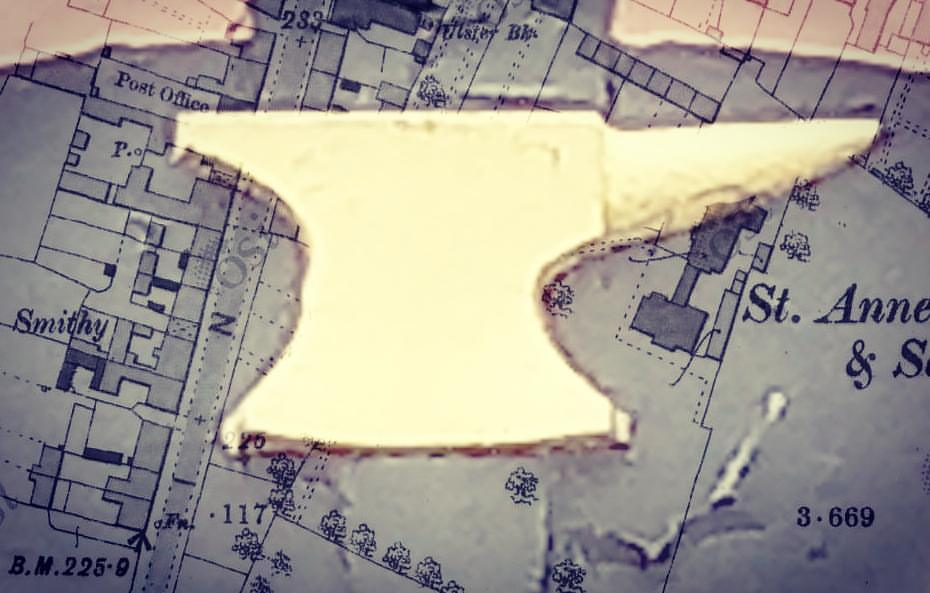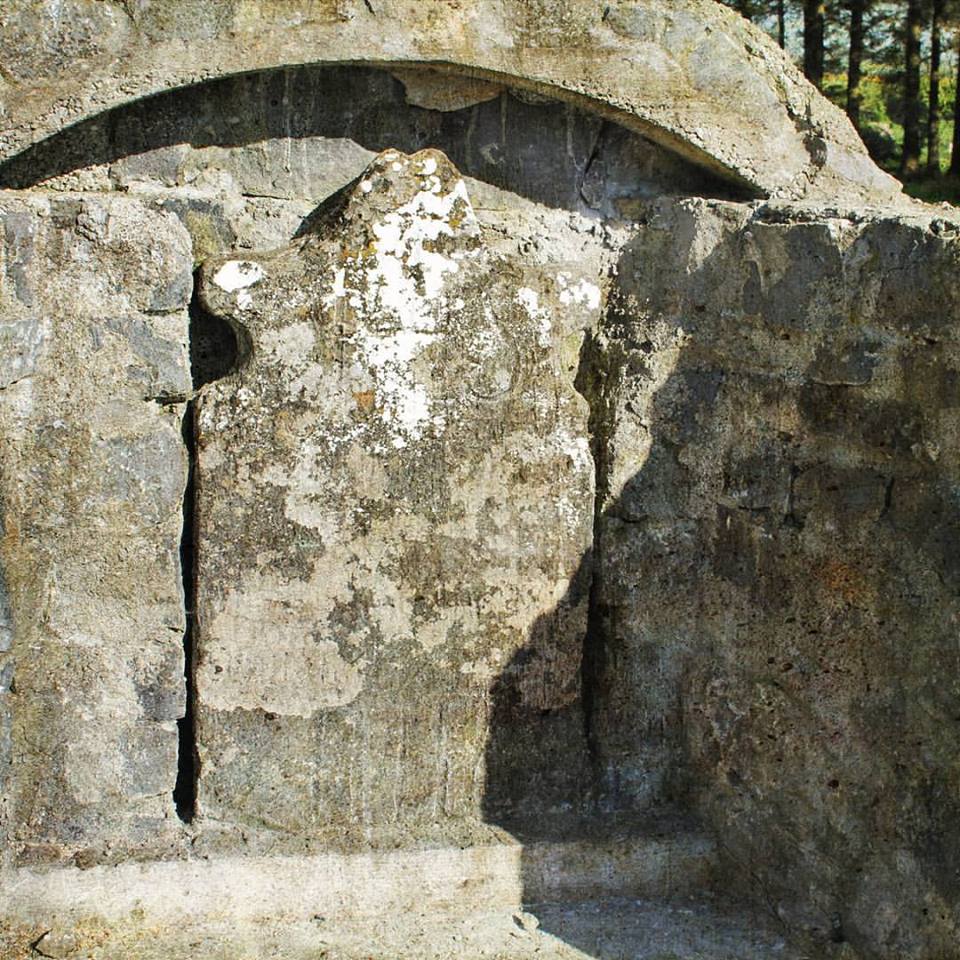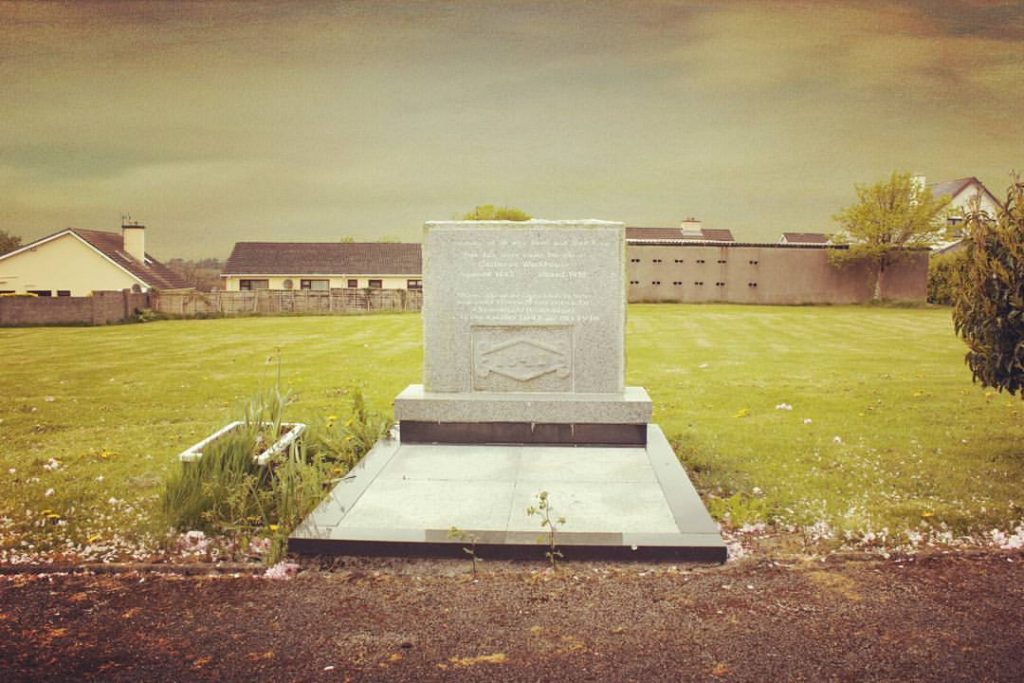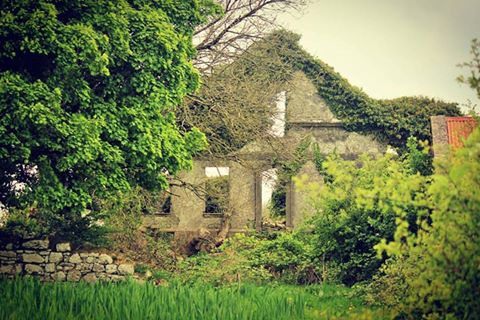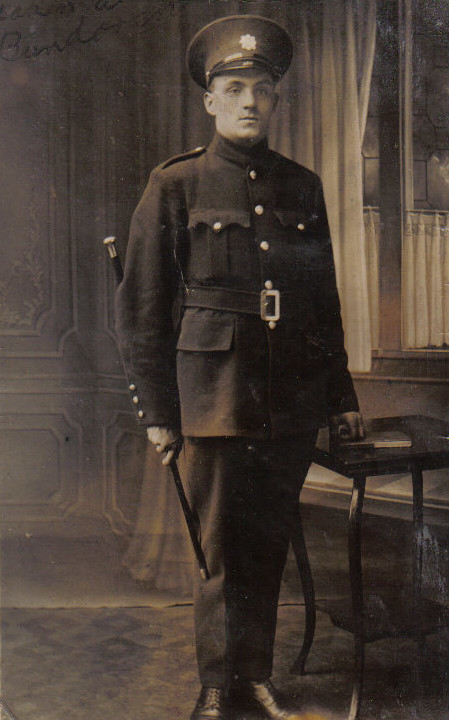An anvil motif carved on the keystone is found on top on the laneway arch indicating that a smith was resident and working from this location sometime in the past. A ‘smithy’ is depicted here in the ordinance survey of c1895 on the road that was called in those days New Line. The name and road were comparatively new additions to the town when the map was drawn up signalling that the smithy and his family could have arrived within their own generation, as urbanisation occurred.
The closest census returns for this period, that of 1901, list a couple of possibilities including a Francis Hayden and a John McCormack who were both working as smiths on this road and may have been the resident worker on this site.
Fr Augustine Plunkett memorial sss
In the town land of Drishaghaun lies an ancient roughly cut flag of limestone that commemorates Fr Augustine Plunkett, “Fryer of Bellahaunes” who died in 1723. He was born in about 1670 probably in the Plunkett Castle that would lend it’s name to the village of Castleplunkett. Like many nobly born young men he joined the friars of St Augustine in Ballyhaunis where he devoted himself to the order for a time.
Unfortunately, for Plunkett, the relative religious stability in this country came to an abrupt end as Queen Anne came to the throne in England, bringing her intense devotion to the Anglican church with her. This devotion came with a great hatred of Roman Catholicism and saw a reign of persecution hit the churches and monasteries across the land. The abbey at Ballyhaunis was ravaged and Plunkett and his fellow friars were forced to flee. Refuge was sought in his home district where he set up a hospice in Rathmoyle for the sick and destitute.
The stone at Drishaghaun is said to mark the spot where he secretly administered to the faith of locals under the shade of a whitethorn tree, long gone but from which the local name for the monument arises – Crann a Leachta meaning A Tree of the Monument.
While there is no definitive evidence to suggest where Fr Augustine Plunkett is buried it is thought that he was laid to rest in Toberelva graveyard – a short distance from the family castle, where a number of Plunkett head stones from the early 18th century are visible.
1962 All Ireland Finalist sss
Roscommon lost to Kerry 1-12 to 1-6 having conceded the fastest goal scored in the history of All-Ireland Senior Football Championships at 35 seconds.
Back Row – Ronan Craven, John Kelly, Bernie Kyne, Cyril Mahon, Aidan Brady, Eamonn Curley, Oliver Moran
Front Row – Tony Whyte, George Geraghty, Gerry Reilly, Gerry O’Malley (captain), John Joe Breslin, Don Feeley, Des Feeley, John Lynch.
Castlerea Workhouse Stone sss
The stone dated 1841 comes from the original workhouse structure that was built around this time on a six acre site south of Castlerea town. Constructed using the design laid down by Poor Law Commissioner architect George Wilkinson it was one that was repeated to a great extent across the country as places to house the growing destitute Irish. Long thought lost to history the stone was located in recent times and enclosed by a local mason into a standing stone structure on the site of Bully’s Acre in Knockroe. (This term has been used regularly to describe famine or workhouse mass graves with the origin possibly stemming from the Irish word “buile” which can be used to describe someone who is insane)
Initially built to accommodate 1000 paupers the Union Workhouse was completed in 1842 but long running financial issues meant it would be four years until it was finally used to receive the poverty stricken. Running costs for the complex were dependant on the collection of Poor Rates from local landholders but as the famine gripped the country they were less inclined to pay causing lengthy delays and postponements. Furthermore the original cost of rates were set before the famine years and were later seen to be inadequate especially as inmate numbers exceeded capacity.
It was into this environment that the workhouse finally opened it’s doors to the starving masses waiting outside. Quickly the numbers became unbearable with the paupers huddled together in dormitories that became a breeding ground for disease, hunger and death.
Once inside inmates were separated from their families, often not seeing them again, with those that were capable being given menial manual jobs for the sustenance that they would receive. Men were tasked with breaking stones in the workhouse yard which were to be used as gravel for the many pointless famine roads being built while woman regularly worked at domestic duties and caring for the sick indoors. Even the older inmates were put to work with many mending clothes, spinning wool or picking oakum.
The work available however could never cope with the sheer numbers of destitute hungry and for many who entered the workhouse in Castlerea they would not leave alive.
Reports from the period describe in harrowing detail how when a person was near to death they were moved to an area at the rear of the building called the black room. Here they were allowed to die before their corpse was lowered from the window into a vast pit where it was covered with lime.
Details of the exact number of deaths at the workhouse and subsequent burials in Bully’s Acre are unclear but considering that Castlerea and Roscommon as a whole suffered such widespread losses during the famine years the figure is undoubtedly high.
During the Great Famine the population of Roscommon was particularly badly impacted with a population loss of 31% making it the worst hit county in the country
Loughglynn Castle sss
Loughglynn Castle, of which only one tower remains was built on the banks of Lough Glinn by the Fitzgerald’s of Mayo in Norman times. Once an impressive structure in later years the castle was used as a temporary prison before convicts were transported to appropriate holding facilities.
The Dillon family, including Viscount Dillons, have long association with the castle as well as the nearby Loughglynn House
Ballenagare House sss
Following the Cromwellian conquest of Ireland on the mid 17th century many lands of former great Catholic families were confiscated and handed to Protestant settlers. The O’Connor family, who through all adversity had always retained a Catholic faith, were inevitably in Cromwell’s firing line. Their property, lands and power were all taken leaving them literally destitute for a generation.
It was only through the courts in 1720 that Denis O’Connor found justice with a moderate proportion of their ancestral lands restored – including that of Ballenagare. Here he built the modest Ballenagare House which became a meeting point for Catholic families in the area as well as the famed blind bard Turlough O’Carolan. O’Carolan’s harp can nowadays be found at Clonalis House, the ancestral home of The O’Conor Don and home to the direct descendants of Rory O’Conor – the last high king of Ireland.
Diary of Thomas Keher of Ballyglass sss
The following is an almost direct transcription of an autobiographical account of the early life of the author Thomas Keigher formally of Ballyglass and his arrival and subsequent life in the States.
I was born in County Roscommon in Ireland around 1903 and I was educated at Caddlebrook National School, a very small school. When all the registered children were in school, they would number about 60. Some days we had only about 20. I lived about a mile from the school or less. I started to go to school before I was 3 years old. No doubt my mother wanted us out of the way so she could do her work at home. I was the 7th of 10 children born. There were six boys and four girls in our family. The girls were the oldest.
>Ella, Marion and Elizabeth were the three older girls. Then came John, Henry, James, Tom and Dominick. Winifred and Austin were the youngest. For a while we all went to school together. What a time it was for Mother getting ten children ready for school in the morning. One day, my fathers sister, our Aunt Ann sent Ella my oldest sister the passage paid to Boston. Ann lived in Dorchester and was a Mrs. Romer. Her husband was born in Prussia in Germany, and was a building inspector in Boston. He seemed to come from a nice family, was a gentleman all through. Like all men there may have been a time when he was difficult but Aunt Ann had a grand way, she never seemed to be angry or loose her temper. She was a real nice person never spoke loud would always smile and would never, agitate anyone. So that was where Ella came to Romers.
The Romers children were all grown up. One son was a building commissioner at Boston and a daughter was married to an attorney at law. Their one remaining daughter Charlotte taught school in Jamaica Plain. Aunt Ann And Uncle Edward were alone but for Charlotte in their house so they had lots of room. That was the start of the trek of our family to Boston. We all cried until we got sick when Ella left home. My Mother said that it was the first break up of our family. Ella was very young to face the world though my father depended a lot on Aunt Ann, he had no fear that his child would be safe. But still it was like a wake, at home. Mother never stopped crying and praying but at last a letter came and Ella was alright. Then one by one the children started to leave.
My sister Elizabeth died. Marion went to Boston and trained to become a nurse, graduating from Lynn Hospital. She worked all of her life in the city as a school nurse. John became a clerk in a dry good store in another town while Henry went to Dublin to learn the grocery business. James came to Boston where he had little luck and died young leaving behind a wife and two children. At home in Ireland. we were getting better off. I sent home a lot of money from England and my brother Dominick used this to extend the farm.
The trouble with England was getting more complicated each day and all the boys in the villages were on the run whether members of the IRA or not. It was unsafe to get caught by the military or auxiliaries known as the Black and Tans. Because they wore Khaki pants and Royal Irish constabulary black tunics they got the name Black and Tans. It was an awful time for the people of Ireland but then came the truce and the establishment of the Irish Free State. The people were happy to have peace again.
My brother Dominick and I joined the Civic Guard – the new Irish Police Force where we carried no arms. Sadly trouble again descended on the country. The IRA sought to brake the treaty and renew the struggle with England for the freedom of the north Eastern counties. For its part the Free State fought to maintain order and peace with England. The smouldering fires still goes on. Neither side wanted to part with the Ulster counties and that is the way I left it when I resigned from the Civic Guard and came to the USA.
I had learned the plastering trade in England and I thought in a few years I would have enough money to go home marry my girl and even to bring her to America. But the worst depression in the history of the USA was waiting for me to arrive here. I got a few weeks work after coming but then the bottom fell out of everything in a few months and no one was working. People that had money in the banks lost everything. All the banks closed with only Government controlled banks staying opened. My girl wrote to me many times to know why I wasn’t writing and I had to tell her that I couldn’t find work and couldn’t bring her out here and couldn’t go home either. My sister told me to find new lodgings. She had a young family and couldn’t afford to keep idle brothers – there were John, James and I and we were all out of work. So with 25 cents in my pocket I left my sisters house in Malden and went into Boston. I was searching for a place to board and couldn’t find any without a weeks pay in advance but I had no money. Then I met John Driscoll. I had worked before with him plastering and I told him how I was fixed. He gave me some money and found me a room. On the next Monday morning I got a job at the General Electric Plant at Everett. My luck had changed. From then on I found one job or another. I wasn’t particular anymore. Any kind of work I grabbed it and I gave up the idea of plastering.
My Kathleen married a farmer at home. I felt very lost for her and always will.
Sources:
The information was transcribed from Thomas Keigher’s own biography with permission to use this account gratefully received by his family members
An extension of this account concerning Thomas Keigher’s older brother James has been appended here
FINNNN